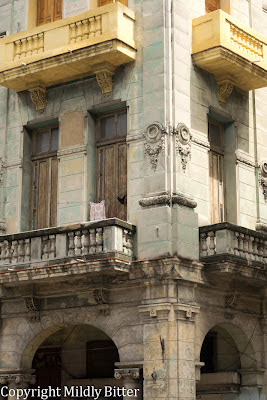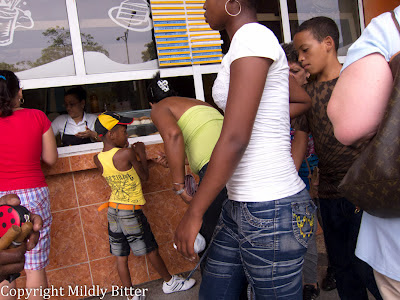Because my trip to Cuba was organized by MoMA the focus was on visual art and artists. We had the great fortune to meet a number of up and coming artists. Many of the artists are associated with the
Ludwig Foundation. The Ludwig Foundation is an approved NGO operating in Cuba. They offer space and opportunities for young artists.
 |
| Ariamna Contino |
We met a collective of artists,
Adrián Fernández,
Alex Hernandez, Maria Cienfuegos and
Frank Mujica,
who share a studio/gallery space called
7 y 60 Visual Arts. I really
loved Fernandez's work and how he moved from photographing public and
private space to fashion style photographs of artificial fruit.
One of the most exciting artists we met was Ariamna Contino. She had several works on display at Ludwig and later we went to the studio/gallery space where she showed us additional ones. Her recent work has been paper cuts that depict celebrities.
We visited the permanent collection at the National Art Museum.
 |
This was my favorite at the National Museum. It is called Secret
Serenade for an Analog Heart by Icaro Zorbar. It
reminded me of Daniel Kitson.
|
We visited several sites where works were being shown for the Havana Bienal. These two were in the Teatro Nacional. We could hear the flamenco dancers rehearsing in one of the rooms off the main entryway. But ladies guarding the room would not let us peek in there.
We visited artist studios including José Toirac's. Toirac is a well-established and well-known Cuban artist. He spoke to us about the work he's been doing some of which the government prevented from being shown in Cuba. He did a series on the First Ladies of Cuba and the Presidents of Cuba. Included in these series were the "good" next to the "bad," U.S. President William Taft, and an empty nail for the next President after Raul Castro. For these three reasons the work could not be shown.
 |
| Work of José
Toirac. Using the idea of politicians kissing babies he depicts the
former leaders of Cuba with their children and grandchildren. |
 |
| Work of José Toirac |
We met brothers Ivan and Yoan Capote who do conceptual sculpture. They own their own building ( a novelty in a country only recently permitting some people to become property owners). They renovated a space to become a modern, hip and air-conditioned studio space.
 |
| Work of Yoan Capote. Actual teeth. |
 |
| Work of Yoan Capote. |
 |
| Work of Yoan Capote. This is made of fishhooks. |
 |
| Work of Yoan Capote. Close-up of fishhooks. |
 |
| Work of Ivan Capote. |
 |
| I believe this is Yoan Capote's work |
This was a Bienal installation called Circus Trieste. It was an installation of an entire circus tent and made to appear that it was left to rot.
 |
| Circus Trieste. |
 |
| Circus Trieste. |
 |
| Circus Trieste. |
We visited the Wilfredo Lam Center. On display for the Bienal was the work of Carlos Garaicoa. He created rugs that appeared to look like the tile entry-ways that used to advertise shops all around Havana.
 |
| Carlos Garaicoa Work |
 |
| The shadows are part of the carpet except for the one on the right. That's me taking the photo. |
We visited the storied art school Superior Institute of Art (ISA). I think most of the young artists we met had graduated from ISA and many were now professors there.
The printmaking department had these old stone tablets used to make labels for cigar boxes.
I ended up buying a linocut from this artist, Osmeivy Ortega Pacheco. He was a student at ISA and now a teacher there.
 |
| Work by Osmeivy Ortega Pacheco |
Painting studio at ISA.
 |
| Painting in Bienal |
Sculpture Studio at ISA.
 |
| Someone call AMPAS |
ISA has a famous campus. It was originally the golf course for the Havana elite before the Revolution. Allegedly Fidel Castro and Che Guevera were walking the grounds after the Revolution and decided they should build an art school in this location. They hired Cuban architect Ricardo Porro. He designed the campus to resemble--and I'm not kidding--the female body, reproductive organs and all. The Domes of the building were meant to represent breasts. The walkways were the fallopian tubes. And there was a Vagina Plaza.
No trip to Cuba is complete without wandering the streets and capturing the incredible architecture that reflects a variety of styles. From Beaux Arts to Art Nouveau to Art Deco to Modernist, the architecture is a real treat.
Wandering through the less-touristed neighborhoods we also encountered some locals. Some even eager to pose for the cameras.
 |
| This woman was doing her best super-model strut and insisted I take a picture. |
Scattered among the incredible buildings are some photo based street art by French
artist Jr. Along with an artist named Jose Parla who works in chalk alongside Jr. we located 8 of the 18 works from the series called "Wrinkles of the City."
 |
| We spotted this one inside the shell of an old Ford factory. The fellas working their let us come in to photograph it. |
 |
| I loved this one on the basketball hoop. |
 |
| Jose Parla chalk work |
 |
| Jr and Jose Parla |
 |
| I love that I managed to capture this little boy bouncing his ball under the photo. |
 |
| Showing the large scale nature of the photos. These were on the outside of an old Ford factory. |





















































Gorgeous photography. I especially love the little boy behind the gate and the last one.
ReplyDelete